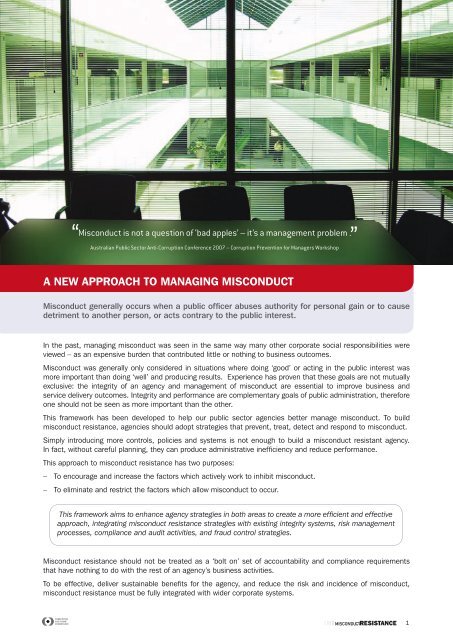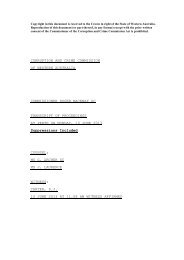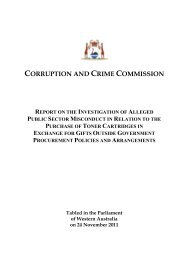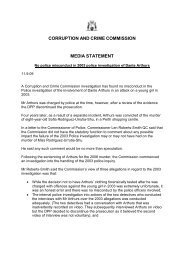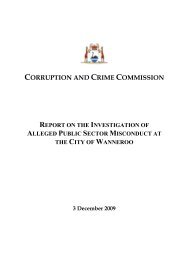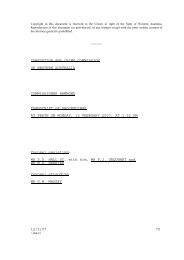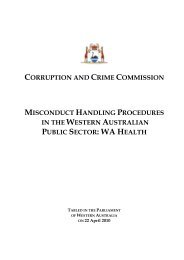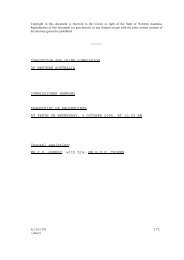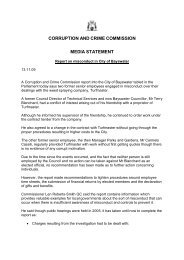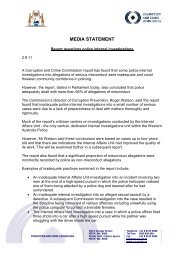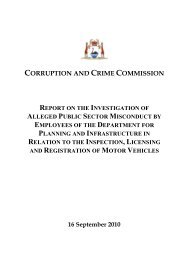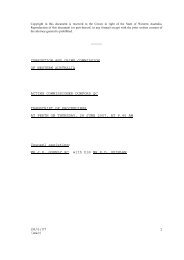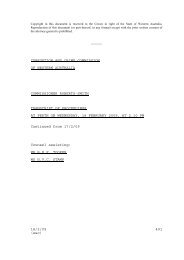Misconduct Resistance Framework - Corruption and Crime ...
Misconduct Resistance Framework - Corruption and Crime ...
Misconduct Resistance Framework - Corruption and Crime ...
You also want an ePaper? Increase the reach of your titles
YUMPU automatically turns print PDFs into web optimized ePapers that Google loves.
“<br />
<strong>Misconduct</strong> is not a question of ‘bad apples’ – it’s a management problem . ”<br />
Australian Public Sector Anti-<strong>Corruption</strong> Conference 2007 – <strong>Corruption</strong> Prevention for Managers Workshop<br />
A NEW APPROACH TO MANAGING MISCONDUCT<br />
<strong>Misconduct</strong> generally occurs when a public officer abuses authority for personal gain or to cause<br />
detriment to another person, or acts contrary to the public interest.<br />
In the past, managing misconduct was seen in the same way many other corporate social responsibilities were<br />
viewed – as an expensive burden that contributed little or nothing to business outcomes.<br />
<strong>Misconduct</strong> was generally only considered in situations where doing ‘good’ or acting in the public interest was<br />
more important than doing ‘well’ <strong>and</strong> producing results. Experience has proven that these goals are not mutually<br />
exclusive: the integrity of an agency <strong>and</strong> management of misconduct are essential to improve business <strong>and</strong><br />
service delivery outcomes. Integrity <strong>and</strong> performance are complementary goals of public administration, therefore<br />
one should not be seen as more important than the other.<br />
This framework has been developed to help our public sector agencies better manage misconduct. To build<br />
misconduct resistance, agencies should adopt strategies that prevent, treat, detect <strong>and</strong> respond to misconduct.<br />
Simply introducing more controls, policies <strong>and</strong> systems is not enough to build a misconduct resistant agency.<br />
In fact, without careful planning, they can produce administrative inefficiency <strong>and</strong> reduce performance.<br />
This approach to misconduct resistance has two purposes:<br />
– To encourage <strong>and</strong> increase the factors which actively work to inhibit misconduct.<br />
– To eliminate <strong>and</strong> restrict the factors which allow misconduct to occur.<br />
This framework aims to enhance agency strategies in both areas to create a more efficient <strong>and</strong> effective<br />
approach, integrating misconduct resistance strategies with existing integrity systems, risk management<br />
processes, compliance <strong>and</strong> audit activities, <strong>and</strong> fraud control strategies.<br />
<strong>Misconduct</strong> resistance should not be treated as a ‘bolt on’ set of accountability <strong>and</strong> compliance requirements<br />
that have nothing to do with the rest of an agency’s business activities.<br />
To be effective, deliver sustainable benefits for the agency, <strong>and</strong> reduce the risk <strong>and</strong> incidence of misconduct,<br />
misconduct resistance must be fully integrated with wider corporate systems.<br />
1


